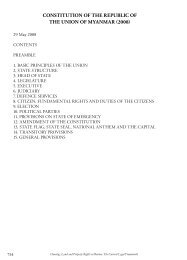Myanmar at the HLP Crossroads: - Displacement Solutions
Myanmar at the HLP Crossroads: - Displacement Solutions
Myanmar at the HLP Crossroads: - Displacement Solutions
You also want an ePaper? Increase the reach of your titles
YUMPU automatically turns print PDFs into web optimized ePapers that Google loves.
<strong>Myanmar</strong> <strong>at</strong> <strong>the</strong> <strong>HLP</strong> <strong>Crossroads</strong> 28Through <strong>the</strong> adoption of progressive land and revenue laws, <strong>the</strong> British cre<strong>at</strong>ed, for <strong>the</strong> first time, a legal arrangementrecognising priv<strong>at</strong>e ownership of land as well as a system of land revenue tax collection. Due to <strong>the</strong> separ<strong>at</strong>eannex<strong>at</strong>ion of Lower and Upper Burma separ<strong>at</strong>e legisl<strong>at</strong>ion was passed to suit <strong>the</strong>se different jurisdictions. TheLand and Revenue Act (1879) was <strong>the</strong> first major land law enacted in Burma and governed <strong>the</strong> acquisition of landrights for priv<strong>at</strong>e persons as well as <strong>the</strong> procedures for assessment and collection of land revenue taxes. Followingthis legisl<strong>at</strong>ion, <strong>the</strong> Upper Burma Land and Revenue Regul<strong>at</strong>ion (1889) was adopted and applied similar principlesof land ownership and land revenue tax collection. Under <strong>the</strong>se laws, all lands in Burma were for <strong>the</strong> first timedivided into ei<strong>the</strong>r “St<strong>at</strong>e land” or “non-St<strong>at</strong>e land”. The Acts did not apply to land within <strong>the</strong> limits of any towns, norto reserved forestry, fisheries land, military cantonments or specified religious sites. Provision was made for <strong>the</strong>accrual of land rights (ordinarily <strong>at</strong>tached to a calcul<strong>at</strong>ed period of possession of land). Fur<strong>the</strong>r, a landowner wasdeemed to have a permanent heritable and transferable right of use and occupancy in his land (subject to paymentof revenue, taxes and <strong>the</strong> reserv<strong>at</strong>ion in favour of <strong>the</strong> government of all mines and mineral products).The cre<strong>at</strong>ion of a system of land revenue tax collection was complementedwith a system of cadastral surveying and land registr<strong>at</strong>ion. The cadastralsurveys distinguished <strong>the</strong> following classes of land: land under grant (longand medium grants); leasehold lands; temporary lease lands (seasonalonly); new colonies (newly opened lands); inund<strong>at</strong>ed and ‘island’ landsfound only in riverine areas (lands submerged under rivers during Monsoonseason, which re-appear when river w<strong>at</strong>er recedes). The land and revenuearrangements instituted by <strong>the</strong> British led to far gre<strong>at</strong>er st<strong>at</strong>e involvementwith <strong>the</strong> land sector as well as far gre<strong>at</strong>er priv<strong>at</strong>e ownership of land than hadpreviously been <strong>the</strong> case, in effect, usurping longstanding customary landusages. Fur<strong>the</strong>r, <strong>the</strong> implement<strong>at</strong>ion of land and revenue arrangements aswell as <strong>the</strong> practice of <strong>the</strong> British led to taxes on land becoming <strong>the</strong> singlelargest source of st<strong>at</strong>e revenue.The Transfer of Property Act (1882) governed <strong>the</strong> law rel<strong>at</strong>ing to <strong>the</strong>transfer of property (movable and immovable), including, sales, mortgages,charges, leases, exchanges and gifts. Although it appears th<strong>at</strong> this Act isstill technically in force, many of <strong>the</strong> relevant <strong>HLP</strong> provisions have beensuperseded, primarily by <strong>the</strong> Land N<strong>at</strong>ionalis<strong>at</strong>ion Act (1953), though thisAct was repealed in accordance with <strong>the</strong> Farmland Law adopted in 2012.The Transfer of Property Act complements <strong>the</strong> position enshrined in <strong>the</strong>Land and Revenue Act th<strong>at</strong> a landowner had a permanent heritable andtransferable right of use and occupancy in his land.The Lower <strong>Myanmar</strong> Town and Village Act (1899) governs land rights of priv<strong>at</strong>e persons in towns and villages(in contrast to <strong>the</strong> Land and Revenue arrangements th<strong>at</strong> cover land outside of towns). The Act provides th<strong>at</strong> <strong>the</strong>following rights to land accrue for hereditary land: <strong>the</strong> right to keep under occupant control (to live and to dwell on<strong>the</strong> land); <strong>the</strong> right to cultiv<strong>at</strong>e; <strong>the</strong> right to mortgage; <strong>the</strong> right to sell and <strong>the</strong> right to inherit. For Government lands,people have rights to keep under occupant control, cultiv<strong>at</strong>e and inherit. The Act st<strong>at</strong>es th<strong>at</strong> “no rights against <strong>the</strong>Government shall be deemed to have been or shall hereafter be, acquired by any person over any land in any townor village, except as provided under this Act”. Similar to <strong>the</strong> Lower Burma Land and Revenue Act, land ownershipis mostly based on possession, again, normally <strong>at</strong>tached to a calcul<strong>at</strong>ed period of possession. The Act provides th<strong>at</strong>landholder’s rights cease after two years of abandonment, and also covers eviction procedures from any unauthorizedpossession and use of st<strong>at</strong>e land.Photo byAndrew Scherer/ <strong>Displacement</strong><strong>Solutions</strong>The Partition Act (1893) governs <strong>the</strong> law rel<strong>at</strong>ing to <strong>the</strong> partition of immovable property. Specifically <strong>the</strong> Actprovides th<strong>at</strong> where a decree for partition has been made and by reason of <strong>the</strong> n<strong>at</strong>ure of <strong>the</strong> property, or <strong>the</strong> numberof shareholders, a division of <strong>the</strong> property cannot be reasonably or conveniently made, <strong>the</strong> Court may direct a sale of<strong>the</strong> property and a distribution of <strong>the</strong> proceeds.The very important Land Acquisition Act (1894) empowers <strong>the</strong> st<strong>at</strong>e to acquire land where it is needed for anypublic purpose. The Act provides for <strong>the</strong> relevant procedures, including <strong>the</strong> required notice to be given, proce-













